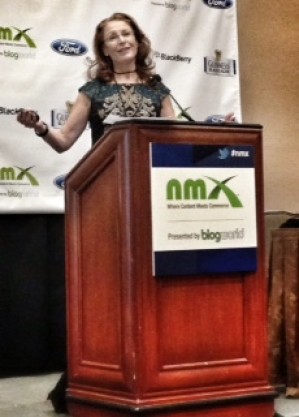 I am amazed at how much Debba Haupert (@girlfriendology) was able to cover in one short session at NMX Las Vegas. Debba’s session on Pinterest proved to be very informational and provided practical advice and tools that marketers can use to better engage their followers.
I am amazed at how much Debba Haupert (@girlfriendology) was able to cover in one short session at NMX Las Vegas. Debba’s session on Pinterest proved to be very informational and provided practical advice and tools that marketers can use to better engage their followers.
Many brands are still struggling to determine if Pinterest is a platform that will work for their business. Companies that have taken the leap may be unsure of how exactly to use Pinterest and what their strategy should be.
The numbers don’t lie. Pinterest has proven that it has staying power.
- 10.4 million users
- 25 million uni visitors/month
- 1/3 use for shipping inspiration
- Average time spent: 1hr 17 min
- Draws more referral traffic than Google+, LinkedIn, and youtube combined
33 Pinterest Best Practices
- Users only have to follow what they like: This means you have an opportunity to only select the categories you are interested in and avoid feed clog (like Twitter).
- Your pins are forever: Unlike a tweet that has the staying power of mere seconds, a pin is a permanent fixture on your board.
- There are SEO benefits: Pinterest is indexed by google and should be part of your backlinking and social linking strategy.
- Content is searchable: Users can search for content by keywords, hashtags, or categories.
- Repins encourage following: After someone re-pins an image from one of your boards they are prompted to begin following you as well.
- Your customers & clients are on Pinterest.
- Your competitors are on Pinterest.
- Generate conversation: You have the opportunity to begin engaging with users by following them or furthering your research on their website.
- Create community: Users can easily embed their social sites and contact information into the Pinterest profile description. This alerts users to all of the ways that they can connect with you.
- Measure, refine, repeat: To determine what has been pinned from your boards you can visit: http://pinterest.com/source/yourURL.com or utilize tools like Repinly.com. Viewing your top pins will help guide your content strategy.
- A like is nice, but a repin is forever.
- It all starts and ends with a photo: The power of Pinterest is all within the images that you use to attract and engage your audience.
- Photos should shine: Each photo should be high quality, engaging, focused, properly cropped, and it should be easy to identify the subject.
- Watermarking your images: In order to protect the images you post on Pinterest you can use a watermark to describe the photo and include your information. Some of the tools that can be used include: picmonkey.com, iwatermark, pixlr.com.
- Image name: Be sure to use search terms and keywords in your image names.
- Before and after: Images that show before and after crafts, weightloss, etc tend to do well on Pinterest.
- Know your audience: It is essential that you are in tune with what your audience likes to consume and share.
- Organize your subjects: If you can keep your boards clean and organized you will improve usability for your followers.
- People like to laugh: Funny quotes tend to be crowd pleasers for any target market.
- Inspire your followers: Find out what motivates your audience and use Pinterest to inspire them to take action.
- DIY: Pinterest was built on the notion of DIY projects and recipes. If applicable, try and share as many of these as possible with your audience.
- Fit a popular category: The most popular categories on Pinterest are: home, arts and crafts, style/fashion, food, inspiration/education, holiday/seasonal, humor, products, travel, kids.
- Consistency is key: Make it your goal to share a helpful tip/image daily.
- Infographics rock Pinterest: Infographics display very nicely on Pinterest and are an eye catcher for your audience.
- Upload pins related to trending topics: If you find something you can write about related to a trending topic, go for it!
- Use keywords in descriptions: The most repinnable keywords are: recipe, chicken, minutes, bake, cake, cheese, cut bottle, step, mix, favorite, cool, top, butter, chocolate, ingredients, try best, baking, pour.
- Include hashtags in descriptions: Hashtags will provide more focus to your image descriptions.
- Be descriptive: Use words in your descriptions that entice and engage your followers.
- Be brief: Shorter descriptions are more effective so keep it short and sweet.
- Product image: If you’re uploading images of your products, be sure to list the price in the description.
- Create a CTA: In general, calls to action lead to an 80% increase in engagement.
- Taller is better: The taller your image, the better it will display on Pinterest.
- Know when to pin: It is important to upload images and engage when your community is pinning.
Each company has a unique group of followers with individual needs. However, the best practices listed above can be implemented across many industries to better attract and engage followers to your Pinterest page. What tips above do you find to be the most useful?


